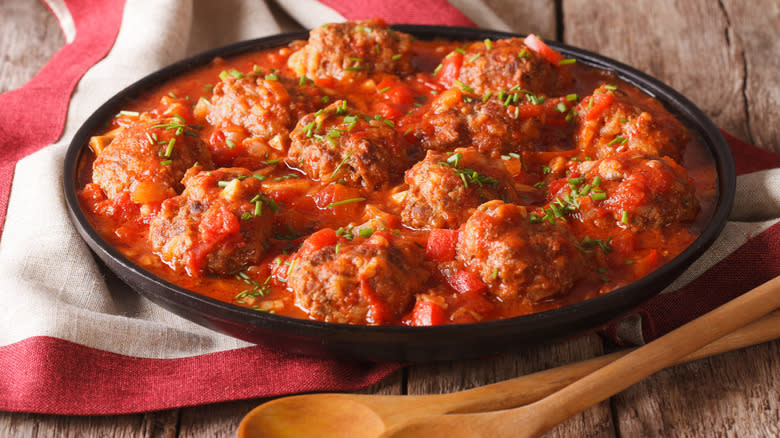The Common Mistake That's Ruining Your Potentially Perfect Meatballs

Making meatballs might seem pretty straightforward, but they can be deceptively tricky to get right. Meatballs are a universal food made in myriad variations, and there are nearly as many mistakes you might be making with meatballs as there are kinds of meatballs to make. One mistake you might be making is not letting those perfect meatballs cook in the sauce.
You'll be giving your meal a one-two punch by letting your meatballs cook in the sauce. The reason is that the meatballs and sauce will meld and flavor each other, and the meatballs will be very tender from the slow, gentle simmer -- think of it as braising your meatballs. Braising, the method of slow-cooking meat in sauce, broth, or other liquid,leads to fork-tender results, and meatballs should be the same. And this method works for all meatballs, not just the version served in marinara. Any kind of meatball can benefit, whether it's an Italian meatball or meatballs in red wine gravy, oyster sauce, or even Ikea's famous Swedish meatballs.
Read more: 15 Tips For Making The Best Meatloaf
Cooking Times And Temps

When braising meat, the rule of thumb to you cook it until it becomes fork-tender, which can sometimes take a whole afternoon to achieve. Luckily, meatballs don't require hours spent simmering away to be tender and juicy. As a general rule of thumb, plan for about 15 to 20 minutes to ensure both your meatballs and your sauce are safe to eat. Your sauce should be at a slow simmer; anything more intense and you risk your meatballs falling apart in the sauce.
Cooking your meatballs with this method isn't a set-and-forget task, you do need to keep an eye on the meatballs as they simmer. If you don't simmer for an adequate amount of time, the meatballs will be raw on the inside, and whatever sauce you've chosen to simmer them in will be tainted with raw meat. Conversely, don't let them go too long; you don't want them to fall apart in your sauce. Your meatballs are finished cooking when they reach an internal temperature of 165 degrees Fahrenheit on a good digital thermometer, according to the USDA.
If you prefer to first sear your meatballs in a pan or par-bake them before adding them to your sauce, let them cool slightly, as they'll be quite fragile while still hot.
Options To Sauces

Meatballs can also be cooked in broth for some extra flavor with the same results. Try cooking your freshly made meatballs in chicken broth for a twist on chicken noodle soup, or the next time you make homemade Italian wedding soup. If you're cooking your meatballs in a creamy broth, cook at a very slow and gentle simmer to avoid scorching the cream on the bottom of the pot, or add the cream later in the braising process.
If you don't have a sauce or broth to simmer in but still want the benefits of a juicy meatball, it's not a problem. Meatballs take very well to steaming. The gentle, moist heat will render the fat in the meatball while still keeping the insides moist. This method is seen a lot in Chinese-style meatballs. You can steam meatballs the same way you would do potsticker dumplings -- after frying, add a small amount of water and cover the pan with a lid to steam the meatballs. You can also steam meatballs in a basket or bamboo steamer.
Read the original article on Daily Meal.
